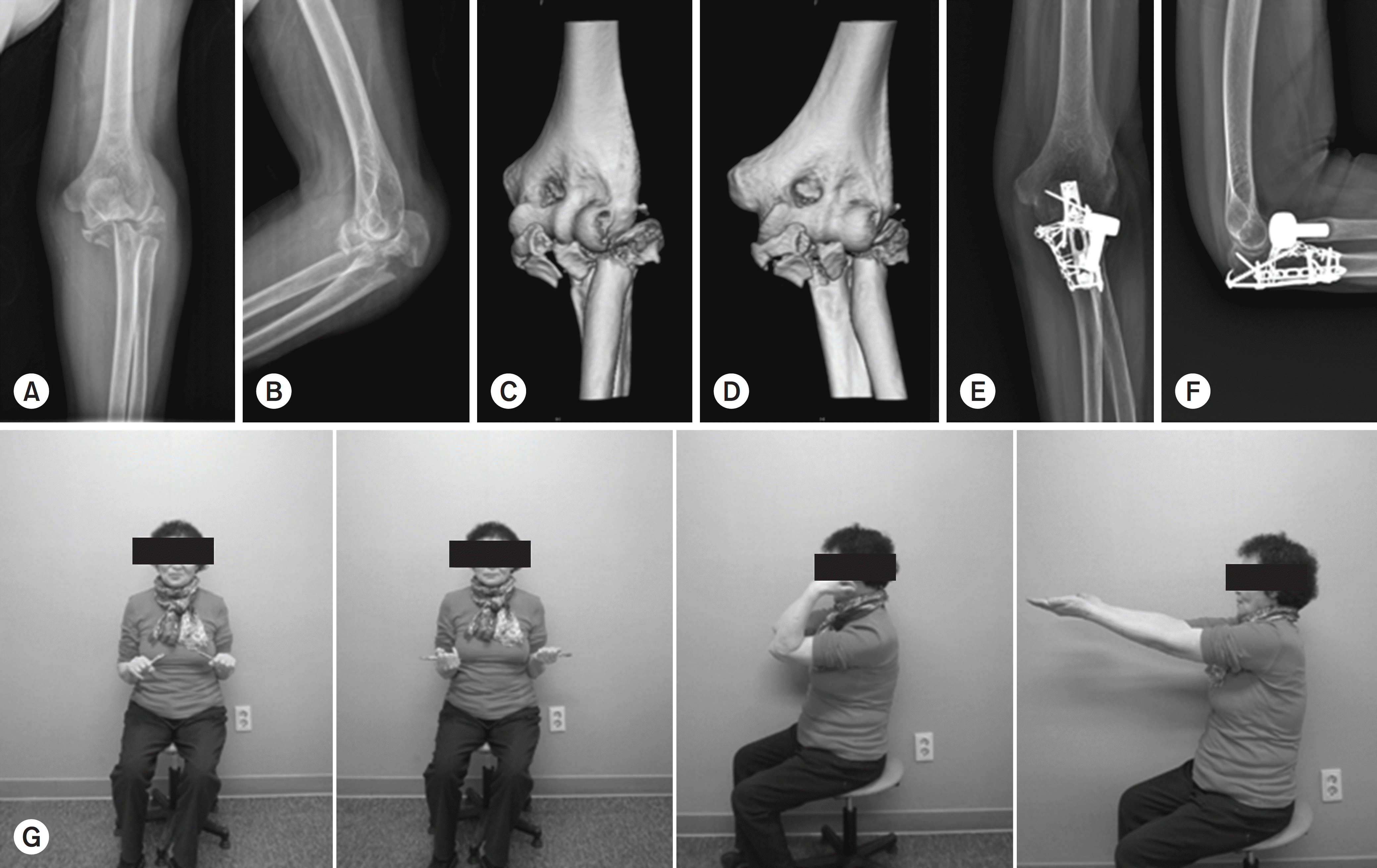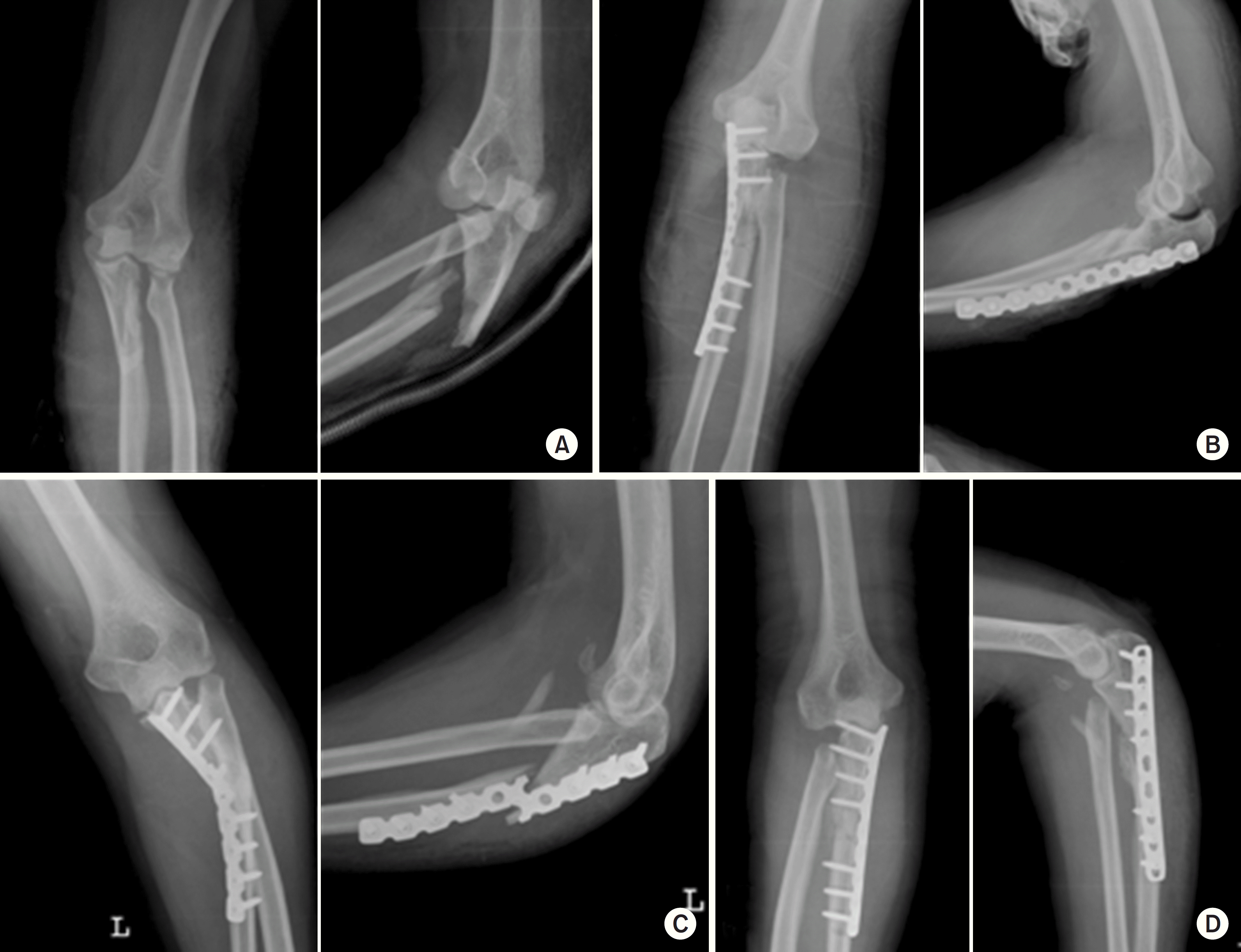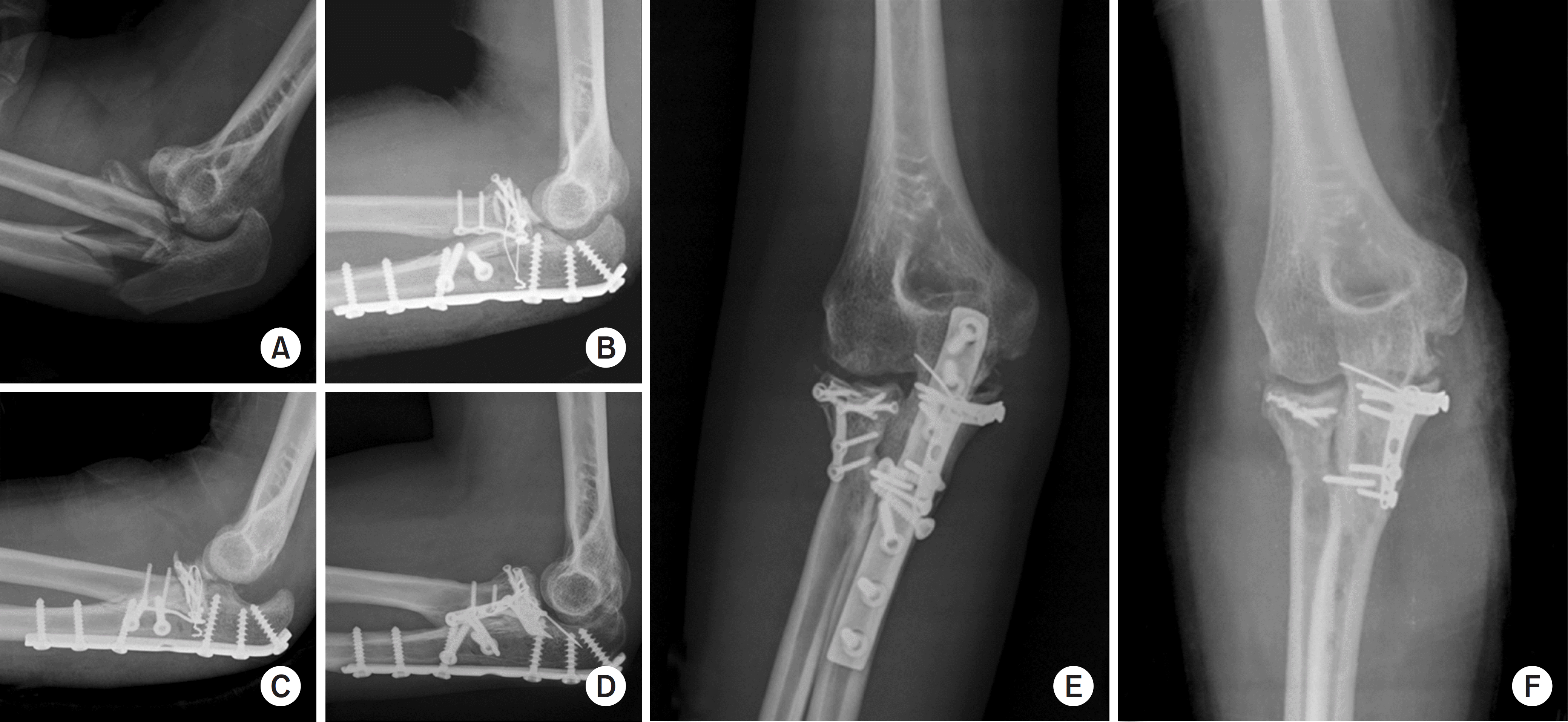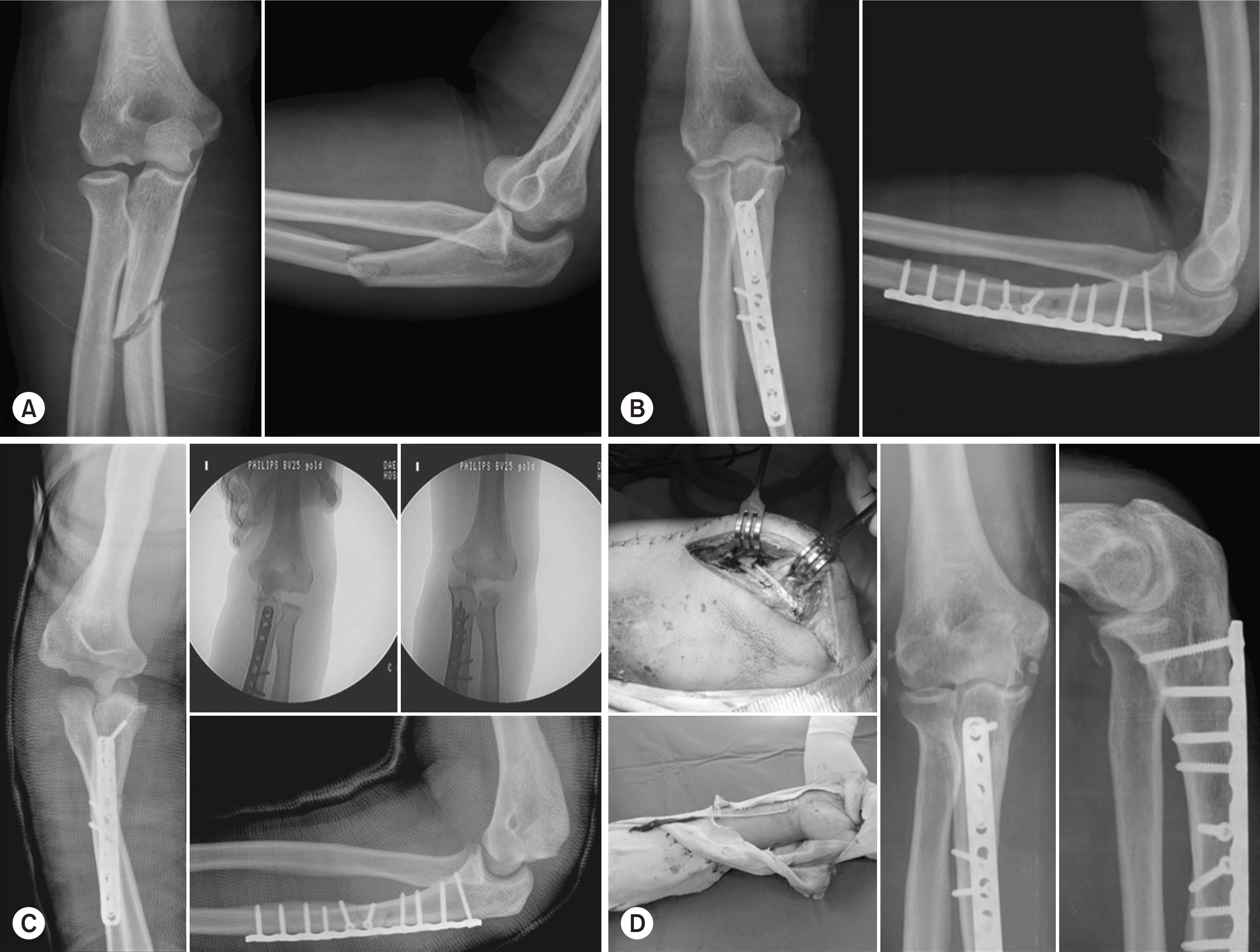Abstract
Purpose
This study examined clinical outcomes of Monteggia fracture type 2, which is the most common in adults with a high rate of accompanied injuries.
Materials and Methods
From June 2004 to November 2015, a retrospective study was performed on 12 patients diagnosed with Monteggia fracture type 2 with a follow-up period of at least 6 months after surgery. The clinical outcomes were evaluated using the Mayo elbow performance score (MEPS), and the existence of accompanied injures, radiological result, and complications were analyzed.
Results
Posterior instability was confirmed in all patients and accompanied fractures were detected in 9 patients (75.0%) on the radial head, whereas 10 patients (83.3%) were found on the coronoid process. The average arc of motion was 107o (70o-130o) and the mean MEPS was 89 (45–100). Additional re-operation due to re-dislocation, radioulnar synostosis, elbow instability, ulna nonunion, and radial head nonunion were performed in 4 cases (33.3%).
Conclusion
The Monteggia fracture type 2 is more commonly associated with radial head fractures and coronoid process fractures rather than other types, which causes elbow instability. Because the rate of additional surgery due to complications is high, the treatment of Monteggia fracture type 2 requires careful assessments.
References
1. Bado JL. The Monteggia lesion. Clin Orthop Relat Res. 50:71–86. 1967.
2. Ring D, Jupiter JB, Simpson NS. Monteggia fractures in adults. J Bone Joint Surg Am. 80:1733–1744. 1998.

3. Jupiter JB, Leibovic SJ, Ribbans W, Wilk RM. The posterior Monteggia lesion. J Orthop Trauma. 5:395–402. 1991.

5. Kamali M. Monteggia fracture. Presentation of an unusual case. J Bone Joint Surg Am. 56:841–843. 1974.
6. Wong JC, Getz CL, Abboud JA. Adult Monteggia and olecranon fracture dislocations of the elbow. Hand Clin. 31:565–580. 2015.

7. Reynders P, De Groote W, Rondia J, Govaerts K, Stoffelen D, Broos PL. Monteggia lesions in adults. A multicenter Bota study. Acta Orthop Belg, 62 Suppl. 1:78–83. 1996.
8. Konrad GG, Kundel K, Kreuz PC, Oberst M, Sudkamp NP. Monteggia fractures in adults: longterm results and prognostic factors. J Bone Joint Surg Br. 89:354–360. 2007.
9. Boyd HB, Boals JC. The Monteggia lesion. A review of 159 cases. Clin Orthop Relat Res. 66:94–100. 1969.
10. Egol KA, Tejwani NC, Bazzi J, Susarla A, Koval KJ. Does a Monteggia variant lesion result in a poor functional outcome?: a retrospective study. Clin Orthop Relat Res. 438:233–238. 2005.
11. Bruce HE, Harvey JP, Wilson JC Jr. Monteggia fractures. J Bone Joint Surg Am. 56:1563–1576. 1974.

12. Givon U, Pritsch M, Levy O, Yosepovich A, Amit Y, Horo-szowski H. Monteggia and equivalent lesions. A study of 41 cases. Clin Orthop Relat Res. 337:208–215. 1997.

13. Strauss EJ, Tejwani NC, Preston CF, Egol KA. The posterior Monteggia lesion with associated ulnohumeral instability. J Bone Joint Surg Br. 88:84–89. 2006.

14. Biyani A, Olscamp AJ, Ebraheim NA. Complications in the management of complex Monteggia-equivalent fractures in adults. Am J Orthop (Belle Mead NJ). 29:115–118. 2000.
15. Llusà Perez M, Lamas C, Martínez I, Pidemunt G, Mir X. Monteggia fractures in adults. Review of 54 cases. Chir Main. 21:293–297. 2002.

16. Karbach LE, Elfar J. Elbow instability: anatomy, biomechanics, diagnostic maneuvers, and testing. J Hand Surg Am. 42:118–126. 2017.

17. O'Driscoll SW. Classification and evaluation of recurrent instability of the elbow. Clin Orthop Relat Res. 370:34–43. 2000.
18. Ring D, Hannouche D, Jupiter JB. Surgical treatment of persistent dislocation or subluxation of the ulnohumeral joint after fracture-dislocation of the elbow. J Hand Surg Am. 29:470–480. 2004.

19. Matar HE, Akimau PI, Stanley D, Ali AA. Surgical treatment of Monteggia variant fracture dislocations of the elbow in adults: surgical technique and clinical outcomes. Eur J Orthop Surg Traumatol. 27:599–605. 2017.

Fig. 1.
A 66-year-old woman fell on the ground and injured her left elbow (Jupiter's Type 2A fracture dislocation associated with a radial head fracture and coronoid process fracture). (A) Initial anteroposterior. (B) Initial lateral view. (C, D) Three-dimensional computed tomography. (E) Anteroposterior view 32 months after the open reduction and internal fixation of ulna, replacement of the radial head and repair of medial collateral ligament & lateral collateral ligament. (F) Lateral view 32 months after surgery. (G) On the last follow-up, 32 months after surgery, range of motion=10o-125o, Mayo elbow performance score=100 (excellent).

Fig. 2.
A 39-year-old woman fell from a height and injured her left elbow (Jupiter's Type 2C fracture dislocation associated with radial head fracture). (A) Initial anteroposterior & lateral views. (B) Postoperative anteroposterior & lateral views after open reduction and internal fixation & radial head excision. (C) Metal failure 3 months after surgery. (D) Postoperative anteroposterior & lateral views after 2nd surgery. On the last follow-up at 57 months after 2nd surgery, range of motion=20o-100o, Mayo elbow performance score=75 (good) with elbow instability.

Fig. 3.
A 22-year-old woman fell from a height and injured her right elbow (Jupiter's Type 2D fracture dislocation associated with the radial head fracture and coronoid process fracture). (A) Initial lateral view. (B) Postoperative lateral view. (C) Lateral view 3 weeks after surgery (instability of elbow joint). (D) Postoperative lateral view after the 2nd surgery (additional plate fixation at coronoid process). (E) Radioulnar synostosis 18 months after the 2nd surgery. (F) Postoperative anteroposterior view after the 3rd surgery (ostectomy & partial implant removal). On the last follow-up of 25 months after the first surgery and range of motion=10o-120o, Mayo elbow performance score=95 (excellent).

Fig. 4.
A 40-year-old man injured by a motor cycle traffic accident and injured his right elbow (Jupiter's Type 2C fracture dislocation associated with lateral ulnar collateral ligament rupture). (A) Initial anteroposterior & lateral views. (B) Postoperative anteroposterior & lateral views after open reduction and internal fixation. (C) Elbow instability 9 days after surgery. (D) Reconstruction of the lateral ulnar collateral ligament with palmaris longus tendon & postoperative anteroposterior & lateral views after 2nd surgery. On the last follow-up 34 months after the 2nd surgery, range of motion=20o-126o, Mayo elbow performance score=100 (excellent).

Table 1.
Demographics of the Patients
J: Jupiter classification, RH: radial head fracture, Co: coronoid process fracture, LI: ligament injury, FC: flexion contracture, AM: arc of motion, Sup: arc of forearm supination, Pro: arc of forearm pronation, MEPS: Mayo elbow performance score, RHT: radial head fracture treatment, AO: additional operation, F: female, M: male, FG: fall on the ground, FH: fall from a height, TA: traffic accident, RE: radial head replacement, OR: open reduction and internal fixation, C: conservative treatment, RHE: radial head excision.




 PDF
PDF ePub
ePub Citation
Citation Print
Print


 XML Download
XML Download